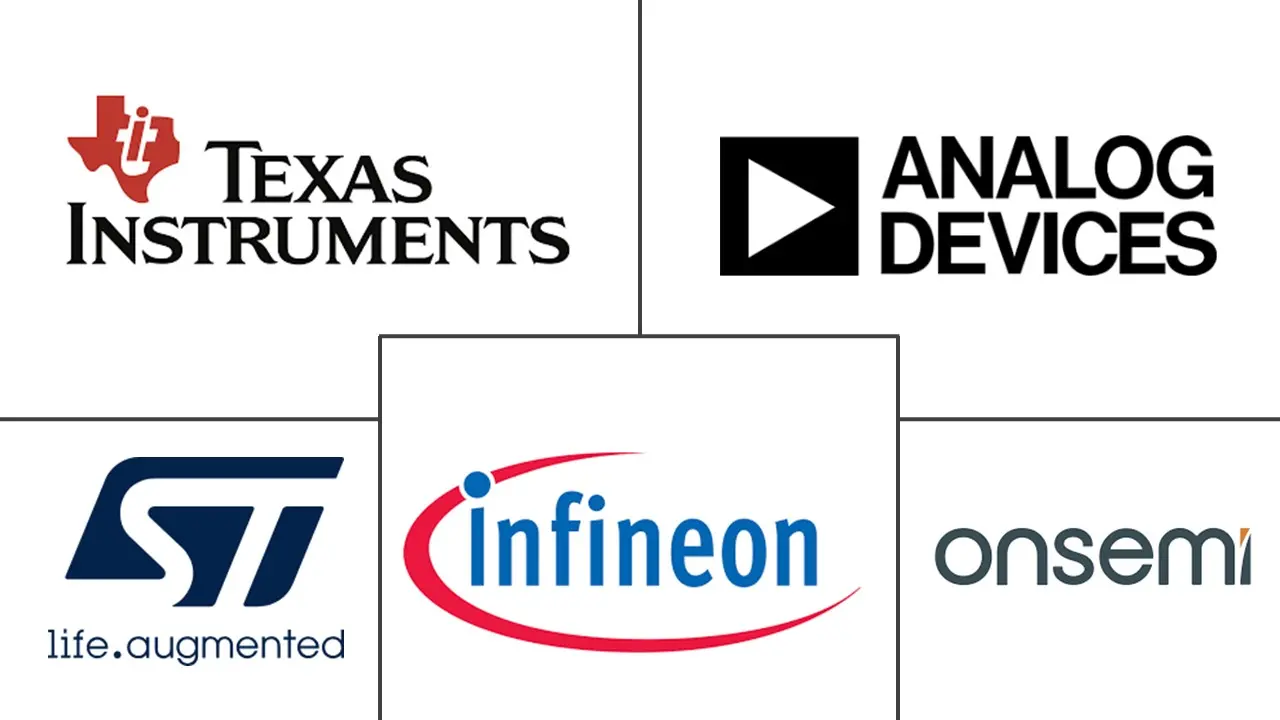Analog Integrated Circuit (IC) Market Size and Share
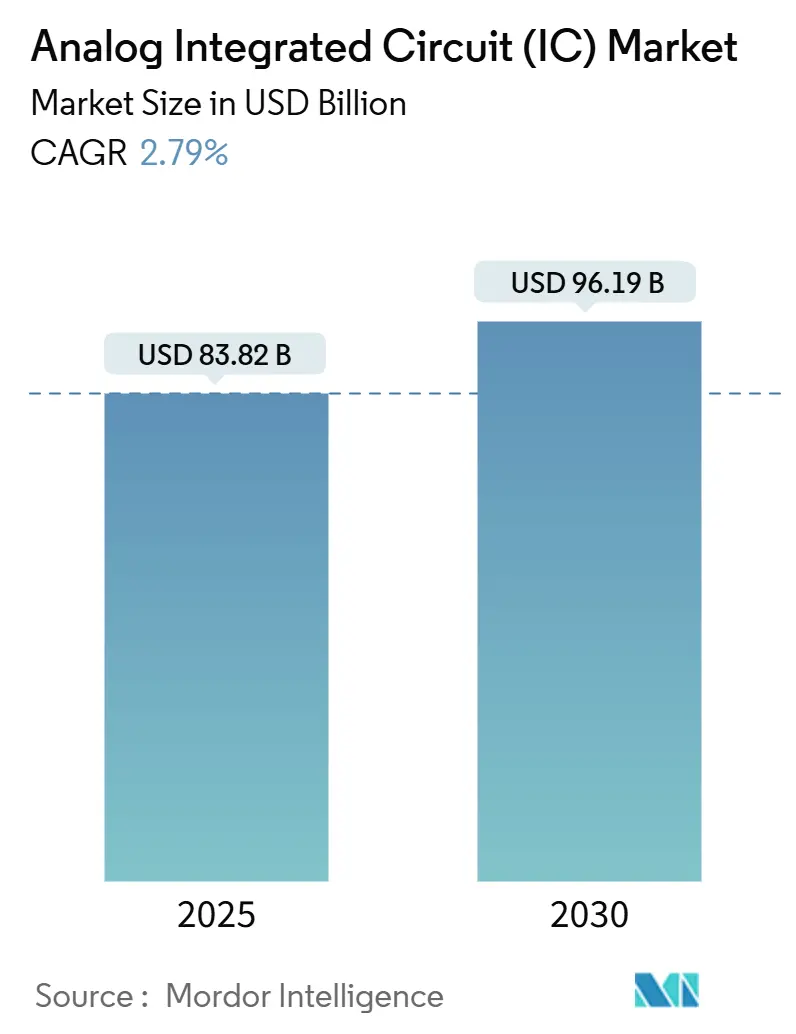
Analog Integrated Circuit (IC) Market Analysis by Mordor Intelligence
The analog IC market size is valued at USD 83.82 billion in 2025 and is forecast to reach USD 96.19 billion by 2030, expanding at a 2.79% CAGR. Market growth reflects steady demand for power-efficient signal conditioning, battery management, and RF front-end solutions across automotive electrification, 5G/6G roll-outs, and industrial automation initiatives. Intensifying edge-AI inference pushes premium pricing for high-accuracy power-management and interface devices, while mature technology nodes remain profitable owing to lower design risk and strong yields. Capacity shifts toward 300 mm fabs improve cost structure and enable tighter analog-digital integration, yet skilled mixed-signal talent shortages and cyclical consumer demand continue to temper output expansion. Nevertheless, the analog IC market demonstrates resilience because its precision functions cannot be fully commoditized or digitized.
Key Report Takeaways
- By type, power-management ICs held 31.2% analog IC market share in 2024; the segment is projected to post the highest 4.1% CAGR through 2030.
- By technology node, processes above 65 nm captured 43.4% of the analog IC market size in 2024, while nodes at 28 nm and below are forecast to expand at a 3.9% CAGR between 2025-2030.
- By wafer size, 200 mm production maintained a 37.8% share of the analog IC market size in 2024; 300 mm capacity is advancing at a 3.7% CAGR to 2030.
- By geography, Asia-Pacific commanded 50.4% analog IC market share in 2024 and is expected to grow at a 4.5% CAGR through 2030.
Global Analog Integrated Circuit (IC) Market Trends and Insights
Driver Imapct Analysis
| DRIVER | (~) % IMPACT ON CAGR FORECAST | GEOGRAPHIC RELEVANCE | IMPACT TIMELINE |
|---|---|---|---|
| 5G/6G RF content per handset | +0.4% | Asia-Pacific, North America | Medium term (2-4 years) |
| EV power-train electrification | +0.6% | China, Europe, North America | Long term (≥ 4 years) |
| Industrial automation (Industry 4.0) | +0.3% | Germany, Japan, South Korea | Medium term (2-4 years) |
| Edge-AI precision power-management | +0.5% | Global data-center hubs | Short term (≤ 2 years) |
| Next-gen satellite constellations | +0.2% | United States, Europe, China | Long term (≥ 4 years) |
| Smart meter retrofit programs | +0.3% | Asia-Pacific, Latin America, Africa | Medium term (2-4 years) |
| Source: Mordor Intelligence | |||
Accelerating 5G/6G RF Front-End Content Per Handset
Analog content per premium smartphone climbed from USD 18 in 4G devices to USD 25 in 5G models as Doherty GaAs amplifiers now deliver 31 dBm linear power with 34% efficiency, while 40 nm CMOS receivers achieve 39 dB gain at 60 GHz.[1]Applied Sciences Editorial Board, “Advanced Doherty Power Amplifier Architectures for 5G Handset Applications,” mdpi.com FinFET-based RF circuits support millimeter-wave beamforming, increasing demand for precision phase-shifter and low-noise amplifier ICs. Massive-MIMO base-station roll-outs require envelope-tracking drivers and high-linearity mixers that remain firmly analog. Component complexity justifies premium average selling prices, sustaining the analog IC market despite handset unit volatility. Supply-chain localization initiatives in Asia-Pacific accelerate regional analog capacity additions.
Rapid EV Power-Train Electrification Boosting High-Voltage Analog Demand
High-voltage battery-management ICs now monitor 14-cell stacks with 16-bit accuracy and daisy-chain up to 31 devices, ensuring functional safety in 800 V packs.[2]STMicroelectronics, “L9963E Battery-Management IC,” st.com Infineon’s 1200 V SiC MOSFETs with top-side cooling lower thermal resistance, enabling compact 11 kW onboard chargers that reach 95% efficiency.[3]Infineon Technologies AG, “CoolSiC Automotive MOSFET 1200 V,” infineon.com Transition from 400 V to 800 V architectures drives gate-driver IC innovation and precision current sensing. Auto OEM qualification cycles lock-in multiyear analog content, anchoring long-term revenue streams for suppliers and reinforcing analog IC market stability. Government incentives for zero-emission vehicles in China, Europe, and the United States further magnify demand.
Industrial Automation Ramp-Up (Industry 4.0, IIoT)
Factory modernization requires 24-bit ADCs and low-noise instrumentation amplifiers to extract predictive-maintenance insights from vibration and thermal sensors. Decentralized control nodes embed ultra-low-power transceivers, increasing shipments of protocol-agnostic interface ICs. Harsh-environment EMC regulations favor analog front-ends with integrated diagnostics and failsafe modes, supporting growth in the analog IC market. Robotics deployments need sub-microsecond response comparators, while servo drives adopt high-resolution DACs to improve positional accuracy. Germany, Japan and South Korea spearhead uptake, influencing global supply chains.
Edge-AI Inference Requiring Precision Power-Management
AI accelerators draw multi-kilowatt currents that fluctuate within microseconds, forcing regulators to deliver <1 mV droop. Vertical-power-delivery PMICs cut conversion losses by 20% and provide 20× faster transient response than conventional converters. Compute-in-memory analog engines achieve 2,900 TOPS/W, yet they depend on tight voltage rails to sustain accuracy.[4]imec R&D, “Analog Inference Accelerator,” imec-int.com Dynamic-voltage-frequency-scaling domains per core raise the count of independent regulators above 40 on next-gen chips, multiplying analog IC sockets. Data-center operators prioritize efficiency to reduce operational carbon footprints, reinforcing near-term demand.
Restraints Impact Analysis
| RESTRAINTS | (~) % IMPACT ON CAGR FORECAST | GEOGRAPHIC RELEVANCE | IMPACT TIMELINE |
|---|---|---|---|
| Sub-28 nm design complexity and verification cost | -0.3% | Global advanced-node hubs | Medium term (2-4 years) |
| Consumer-electronics demand volatility | -0.4% | Asia-Pacific manufacturing clusters | Short term (≤ 2 years) |
| Analog talent shortage | -0.5% | United States, Europe, Asia-Pacific | Long term (≥ 4 years) |
| GaN/SiC module integration lowers the discrete BOM | -0.2% | Automotive and power-conversion segments | Medium term (2-4 years) |
| Source: Mordor Intelligence | |||
Rising Design Complexity and Verification Cost for Sub-28 nm Analog
FinFET and gate-all-around structures introduce variability that invalidates classical analog layout heuristics; verification cycles now span 36 months and mask sets exceed USD 5 million, limiting entry for small firms. Analog IP migration across nodes demands extensive silicon characterization, raising non-recurring engineering costs. Only high-volume platforms justify such investment, concentrating market power among cash-rich players. EDA limitations delay time-to-market, suppressing analog IC market velocity in advanced nodes.
Chronic Analog Talent Shortage in Mixed-Signal Layout and Test Engineering
Unlike digital synthesis flows, analog design depends on tacit knowledge and iterative bench testing, making full automation impossible. As a result, rising recruitment costs, slipping project schedules, and escalating quality risks constrain the analog IC market's capacity, even in the face of ample capex.
Segment Analysis
By Type: Power Management Drives Market Evolution
Power-management products account for 31.2 of % analog IC market share in 2024 and will grow at a 4.1% CAGR through 2030, propelled by AI data-center vertical-power delivery and 800 V EV drivetrains. Interface ICs remain second in revenue thanks to proliferating connectivity standards. Programmable PMICs with ISO 26262 compliance now embed diagnostic ADCs, watchdog timers, and CAN/LIN transceivers, enabling single-chip power and communication modules. Machine-learning-enabled PMICs optimize energy dynamically, illustrating the convergence of analog control loops with embedded intelligence.
Signal-conversion components, including ADCs and DACs, benefit from ubiquitous sensing in industrial and consumer devices, but unit ASPs face competitive pressure from high-volume microcontroller vendors bundling converter IP. Amplifiers and comparators retain relevance in instrumentation and RF chains where noise, bandwidth, and offset parameters drive design-in decisions. Collectively, diversified applications insulate the analog IC market from segment-specific downturns.
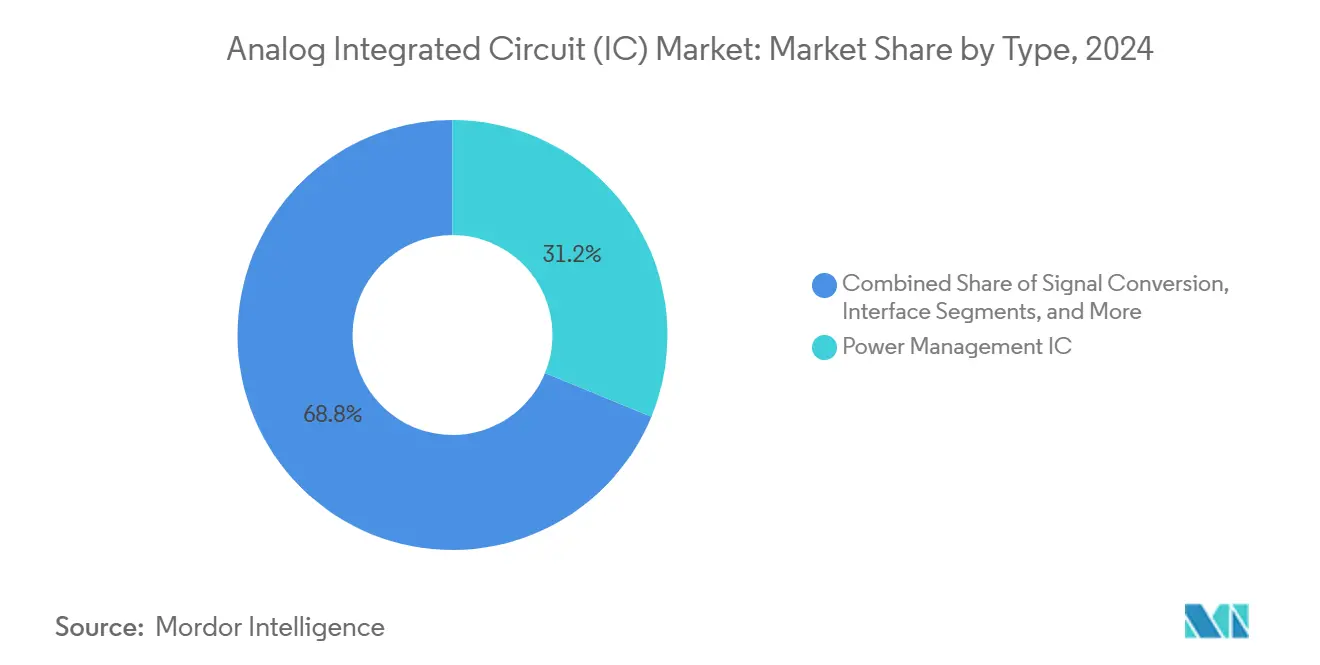
Note: Segment shares of all individual segments available upon report purchase
By Technology Node: Mature Processes Maintain Relevance
Nodes above 65 nm secured 43.4% analog IC market share in 2024. Automotive and industrial customers favor these geometries for robust analog characteristics and qualified reliability up to 175 °C junction. Nonetheless, sub-28 nm deployments will post the fastest 3.9% CAGR as system-on-chip architectures integrate precision analog close to digital logic, raising functional density within the analog IC market. FD-SOI at 18 nm offers analog designers low-noise transistors and body-bias control, striking a balance between cost and performance. 28-40 nm remains the sweet spot for mixed-signal microcontrollers combining RF, sensor-hub, and power-management blocks.
Process selection increasingly aligns with the application life cycle rather than pure scaling. Advanced packaging, such as 2.5D interposers, enables heterogeneous integration, placing analog on 65 nm while GPU tiles adopt 5 nm, providing optimization without sacrificing yields. Consequently, mature fabs retain high utilization, reinforcing profit stability for the analog IC market.
By Wafer Size: 300 mm Transition Accelerates
While 200 mm fabs continue to produce 37.8% of 2024 unit volume, 300 mm lines exhibit a 3.7% CAGR because larger substrates cut die cost by up to 27% and support advanced BEOL options like TSVs for 3D stacked die. Texas Instruments’ USD 1.6 billion CHIPS-Act-funded triplet of 300 mm fabs underscores domestic capacity reversal.
However, specialty materials SiC, GaN, and SOI often remain on 150-200 mm tools due to equipment maturity. Infineon’s 200 mm SiC pilot line exemplifies this dual-track strategy [5]Semiconductor Today, “Infineon 200 mm SiC Wafers,” semiconductor-today.com. Suppliers hedge exposure by maintaining flexible tool sets across diameters, safeguarding supply for the analog IC market during capacity shifts.
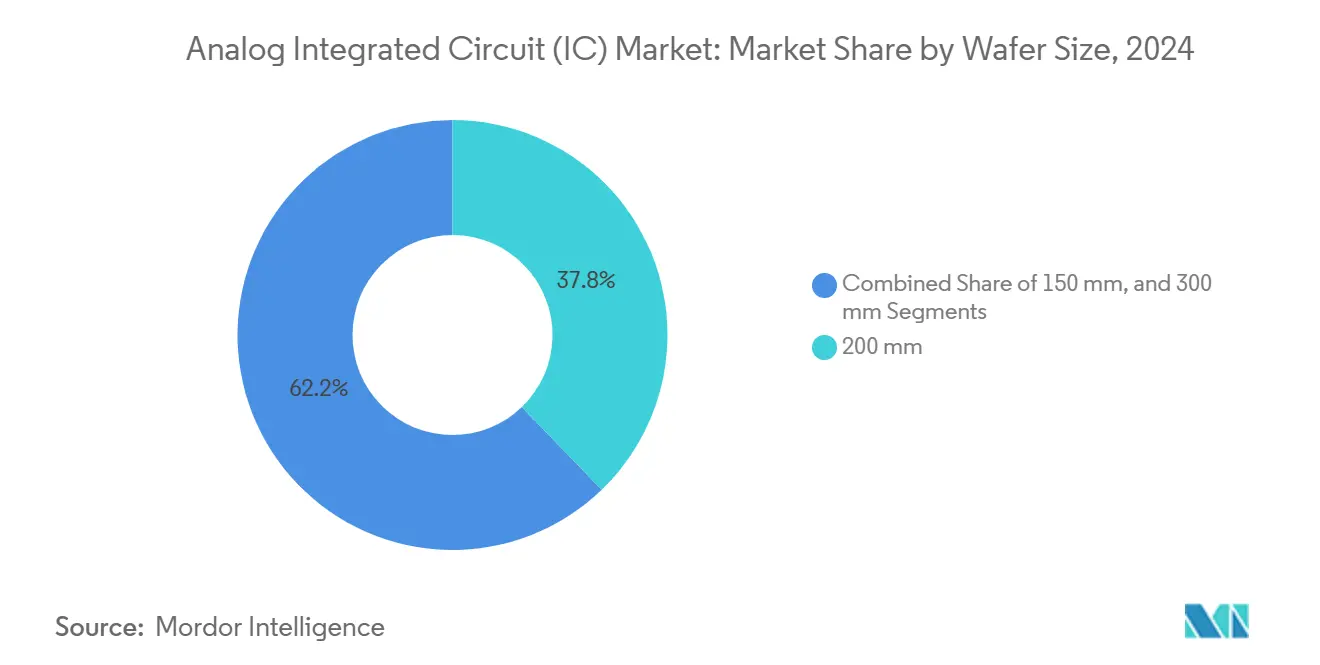
Note: Segment shares of all individual segments available upon report purchase
Geography Analysis
Asia-Pacific captured 50.4% of the analog IC market share in 2024 and is forecast to expand at a 4.5% CAGR. China’s domestic sales rose from USD 500 million in 2016 to USD 1.732 billion in 2023, mirroring state-backed self-sufficiency goals. India’s 222 million-unit smart-meter program secures sizable analog content pipelines, while Japan revives analog IC capacity via public-private partnerships. Regional fabs capitalize on subsidies to localize supply chains, enhancing lead-time agility and lowering logistics risks for global OEMs.
North America leverages CHIPS-Act incentives to triple fab capacity by 2032; analog IC producers target defense and automotive customers seeking geographically diversified sources. Europe’s regulatory acumen in functional safety and environmental compliance sustains high-value niches, buttressed by the European Chips Act’s ambition for a 20% global output share. Emerging markets in Latin America and Africa adopt cost-optimized analog solutions for grid modernization and connectivity upgrades, albeit from a smaller base.
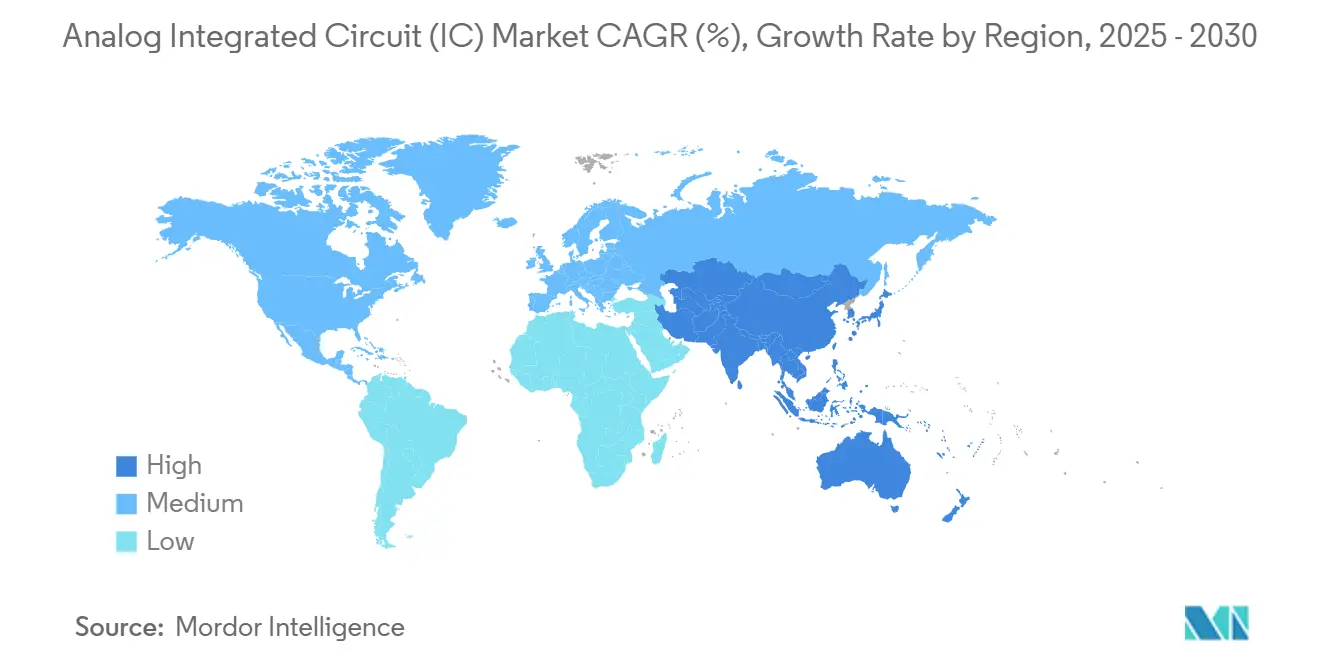
Competitive Landscape
The analog IC market displays moderate concentration. Texas Instruments led 2024 analog revenue with USD 3.21 billion in Q1 alone, demonstrating economies of scale in 300 mm production and catalog breadth. Analog Devices champions high-precision converters for instrumentation and aerospace, while Infineon dominates automotive power semiconductors with SiC and GaN portfolios. onsemi’s acquisition of Qorvo’s SiC JFET assets added a USD 1.3 billion addressable market in data-center power. STMicroelectronics invests in FD-SOI technologies targeting edge AI and industrial microcontrollers.
Competitive strategy pivots on vertical integration: owning design, wafer fabrication, packaging, and test ensures quality control and supply-chain resilience. Suppliers augment differentiation via application-specific standard product platforms, shortening design-win cycles. Start-ups target niches radiation-hardened electronics, precision time-of-flight imagers, but scaling hurdles persist without captive fabs. Consolidation remains likely, especially among sub-USD 1 billion revenue players pressured by soaring mask and EDA costs.
Collaborative design engagements grow as OEMs co-optimize board-level layouts with supplier reference designs to meet aggressive efficiency and safety targets. This co-innovation culture cements stickiness and lifts switching costs, reinforcing incumbents’ share within the analog IC market.
Analog Integrated Circuit (IC) Industry Leaders
-
Texas Instruments Incorporated
-
Analog Devices Inc.
-
Infineon Technologies AG
-
STMicroelectronics N.V.
-
ON Semiconductor Corporation
- *Disclaimer: Major Players sorted in no particular order
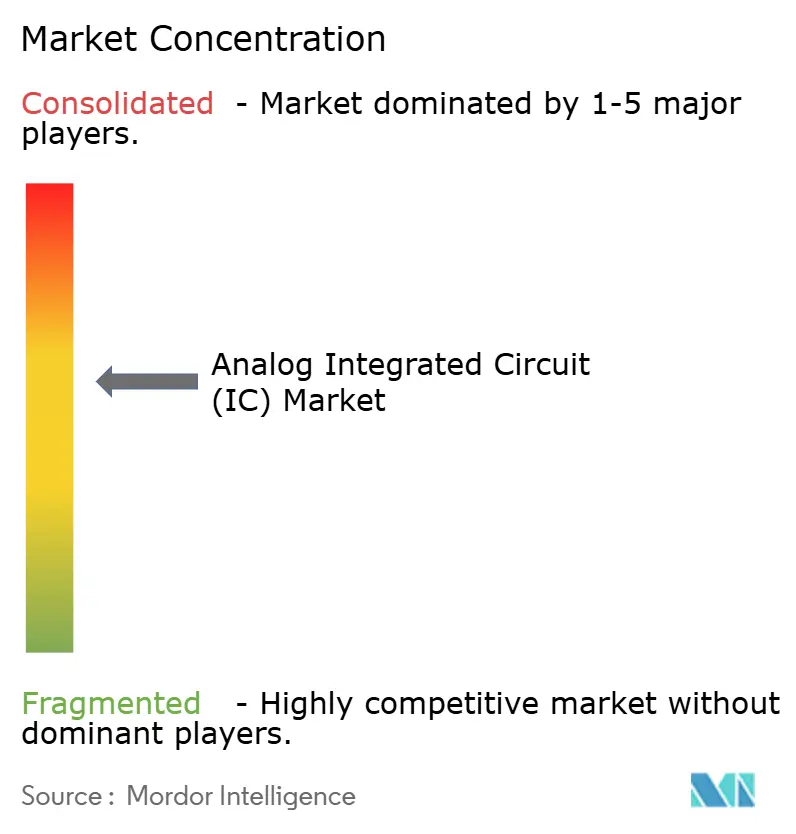
Recent Industry Developments
- May 2025: Infineon Technologies launched JANS-certified radiation-hardened GaN transistors rated at 100 V, 52 A for on-orbit spacecraft power systems.
- April 2025: Texas Instruments unveiled the LMH13000 LiDAR laser driver, CDC6C-Q1 oscillator, and AWR2944P mm-wave radar sensor, broadening its automotive autonomy portfolio.
- April 2025: Infineon introduced industrial GaN transistors with integrated Schottky diode, trimming dead-time losses in 3-kW telecom PSUs.
- February 2025: STMicroelectronics released Teseo VI GNSS receivers delivering centimeter accuracy for ADAS applications.
Global Analog Integrated Circuit (IC) Market Report Scope
An analog integrated circuit is dedicated to designing and applying analog, radio frequency (RF), mixed-signal integrated circuits (ICS), and signal processing circuits and systems. The market is growing, as every digital consumer product, from appliances and cell phones to music players, has analog ICS feeding its digital heart, including other applications, such as automotive, military, and government.
The analog IC market is segmented by type (general-purpose IC (interface, power management, signal conversion, and amplifiers/comparators), application-specific IC (consumer (audio/video and digital still camera and camcorder, and other consumers), automotive (infotainment and other infotainment), communication (cell phone, infrastructure, wired communication, short range, and other wireless), computer (computer system and display, computer periphery, storage, and other computers), and industrial and others)), and geography (North America, Europe, Asia-Pacific, Latin America, and Middle East and Africa). The report offers market forecasts and sizes in volume (units) and value (USD) for all the above segments.
| General-Purpose IC | Interface | |
| Power Management | ||
| Signal Conversion | ||
| Amplifiers / Comparators | ||
| Application-Specific IC | Consumer | Audio / Video |
| Digital Cameras and Camcorders | ||
| Other Consumer Devices | ||
| Automotive | Infotainment | |
| Advanced Driver-Assistance Systems (ADAS) | ||
| Communication | Cell Phone | |
| Infrastructure | ||
| Wired Communication | ||
| Short-Range Wireless | ||
| Computer | System and Display | |
| Peripherals | ||
| Storage | ||
| Industrial and Others | ||
| >65 nm |
| 40–65 nm |
| 28–40 nm |
| ≤28 nm |
| 150 mm |
| 200 mm |
| 300 mm |
| North America | United States | |
| Canada | ||
| Mexico | ||
| South America | Brazil | |
| Argentina | ||
| Rest of South America | ||
| Europe | Germany | |
| United Kingdom | ||
| France | ||
| Russia | ||
| Rest of Europe | ||
| Asia-Pacific | China | |
| Japan | ||
| India | ||
| South Korea | ||
| South-East Asia | ||
| Rest of Asia-Pacific | ||
| Middle East and Africa | Middle East | Saudi Arabia |
| United Arab Emirates | ||
| Rest of Middle East | ||
| Africa | South Africa | |
| Egypt | ||
| Rest of Africa | ||
| By Type | General-Purpose IC | Interface | |
| Power Management | |||
| Signal Conversion | |||
| Amplifiers / Comparators | |||
| Application-Specific IC | Consumer | Audio / Video | |
| Digital Cameras and Camcorders | |||
| Other Consumer Devices | |||
| Automotive | Infotainment | ||
| Advanced Driver-Assistance Systems (ADAS) | |||
| Communication | Cell Phone | ||
| Infrastructure | |||
| Wired Communication | |||
| Short-Range Wireless | |||
| Computer | System and Display | ||
| Peripherals | |||
| Storage | |||
| Industrial and Others | |||
| By Technology Node | >65 nm | ||
| 40–65 nm | |||
| 28–40 nm | |||
| ≤28 nm | |||
| By Wafer Size | 150 mm | ||
| 200 mm | |||
| 300 mm | |||
| By Geography | North America | United States | |
| Canada | |||
| Mexico | |||
| South America | Brazil | ||
| Argentina | |||
| Rest of South America | |||
| Europe | Germany | ||
| United Kingdom | |||
| France | |||
| Russia | |||
| Rest of Europe | |||
| Asia-Pacific | China | ||
| Japan | |||
| India | |||
| South Korea | |||
| South-East Asia | |||
| Rest of Asia-Pacific | |||
| Middle East and Africa | Middle East | Saudi Arabia | |
| United Arab Emirates | |||
| Rest of Middle East | |||
| Africa | South Africa | ||
| Egypt | |||
| Rest of Africa | |||
Key Questions Answered in the Report
What is the projected value of the analog IC market in 2030?
The analog IC market size is forecast to reach USD 96.19 billion by 2030.
Which product category currently leads in revenue contribution?
Power-management ICs command 31.2% analog IC market share and remain the fastest-growing segment.
Which region generates the highest demand for analog ICs?
Asia-Pacific holds 50.4% market share and is expanding at 4.5% CAGR through 2030.
How will 300 mm wafer adoption impact analog IC cost structures?
Transition to 300 mm substrates lowers die cost by up to 27% and supports tighter analog-digital integration, improving supplier margins.
Page last updated on:
